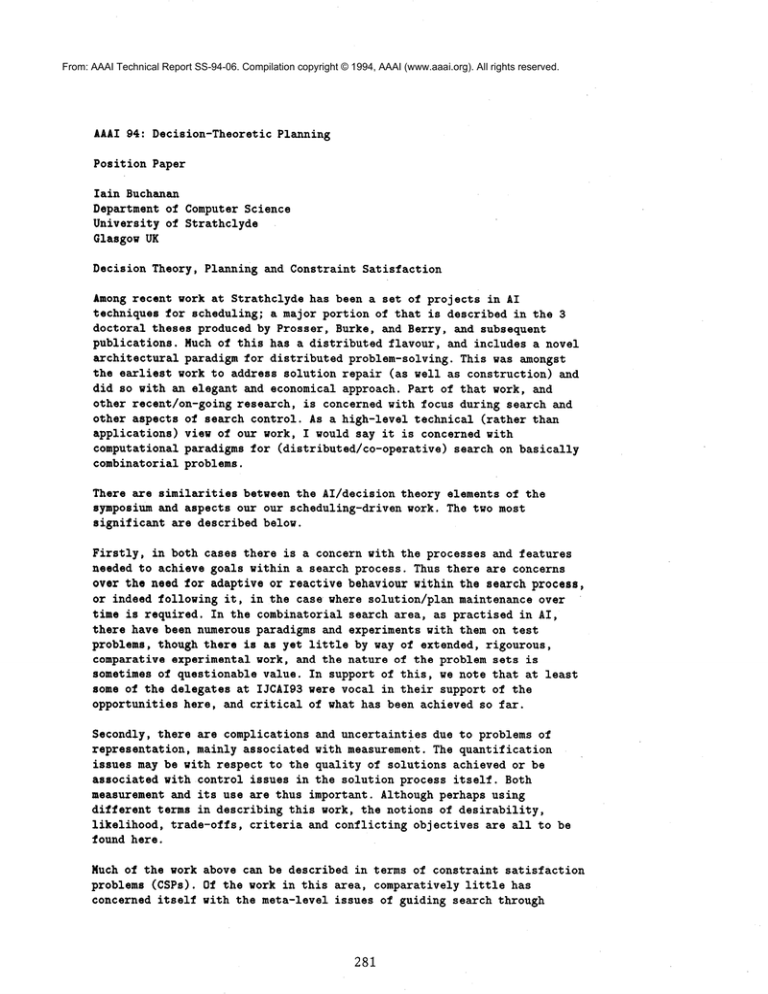
From: AAAI Technical Report SS-94-06. Compilation copyright © 1994, AAAI (www.aaai.org). All rights reserved.
AAAI 94: Decision-Theoretic Planning
Position Paper
Iain Buchanan
Department of Computer Science
University of Strathclyde
Glasgow UK
Decision Theory, Planning and Constraint Satisfaction
Among recent work at Strathclyde has been a set of projects in AI
techniques for scheduling; a major portion of that is described in the 3
doctoral theses produced by Prosser, Burke, and Berry, and subsequent
publications. Much of this has a distributed flavour, and includes a novel
architectural paradigm for distributed problem-solving. This was amongst
the earliest work to address solution repair (as well as construction) and
did so with an elegant and economical approach. Part of that work, and
other recent/on-going research, is concerned with focus during search and
other aspects of search control. As a high-level technical (rather than
applications) view of our work, I would say it is concerned with
computational paradigms for (distributed/co-operative) search on basically
combinatorial problems.
There are similarities between the AI/decision theory elements of the
symposium and aspects our our scheduling-driven work. The two most
significant are described below.
Firstly, in both cases there is a concern with the processes and features
needed to achieve goals within a search process. Thus there are concerns
over the need for adaptive or reactive behaviour within the search process,
or indeed following it, in the case where solution/plan maintenance over
time is required. In the combinatorial search area, as practised in AI,
there have been numerous paradigms and experiments with them on test
problems, though there is as yet little by way of extended, rigourous,
comparative experimental work, and the nature of the problem sets is
sometimes of questionable value. In support of this, we note that at least
some of the delegates at IJCAI93 were vocal in their support of the
opportunities here, and critical of what has been achieved so far.
Secondly, there are complications and uncertainties due to problems of
representation, mainly associated with measurement. The quantification
issues may be with respect to the quality of solutions achieved or be
associated with control issues in the solution process itself. Both
measurement and its use are thus important. Although perhaps using
different terms in describing this work, the notions of desirability,
likelihood, trade-offs, criteria and conflicting objectives are all to be
found here.
Much of the work above can be described in terms of constraint satisfaction
problems (CSPs). Of the work in this area, comparatively little has
concerned itself with the meta-level issues of guiding search through
281
(absolute) measurement; rather the concentration has been at the
algorithmic level and with guiding search through plausible rules or
constraints, sometimes founded on local or surrogate measures. In
constraint satisfaction problems there is now a move to introduce measures,
even if only of a relative type, which could be embedded in meta-level
control strategies. The recent work of Prosser and Smith (following that of
Cheeseman, Kanefsky and Taylor on graph colourinE) is the beginninE of a
quantitative assessment of problem (search) difficulty. The analyses, based
on problem features which are sometimes expressed in terms of likelihoods such as the probability that a constraint exists between a pair of
variables in a constraint satisfaction problem - are both simple and
Supported, at least in part, by experimental evidence.
In terms of taking further the CSP work and examining relationships with
the decision theory and planning worlds, there are a number of open
questions. Included in this set are extensions of the analyses of
Prosser/Smith to more asymmetric and less uniform problem classes, the use
of more sophisticated parameters to describe these classes, and an
investigation of the potential relationships between planning problems and
CSPs, especially if the latter turn out to have measurable qualities which
can be used in meta-level control.
Success in more sophisticated analysis may well rest on alternative
analytic tools, especially those which can provide a handle onto the tree
search cum problem decomposition approach. This may well involve relating
measures across the problem-subproblem interface, which fits well with
traditional methods in decision theory but is so far relatively unexplored
in CSP terms.
Associated with all of this is the determination and exploitation of data
such as the (expected) value of information, or the value of computation.
While these are well-known concepts in decision theory, so far they only
feature in a relatively low key way in the CSP world, and usually are known
by different names.
In summary, there is an opportunity for a rich interaction between the
decision theory/planninE community and other workers with an interest in
apparently distinct areas of modelling and problem-solving.
References
P Cheeseman, B Kanefsky and W M Taylor, "Where the Really Hard Problems
Are", Proc IJCAI91, pp331-337, 1991.
P T Prosser, "An Empirical Study of Phase Transitions in Binary Constraint
Satisfaction Problems", Technical Report AISL-49-93, Dept of Computer
Science, University of Strathclyde, Glasgow UK, December 1993.
B M Smith, "The Phase Transition in Constraint Satisfaction Problems: A
Closer Look at the Mushy Region", Research Report 93.41, School of Computer
Studies, University of Leeds, 1993.
282

